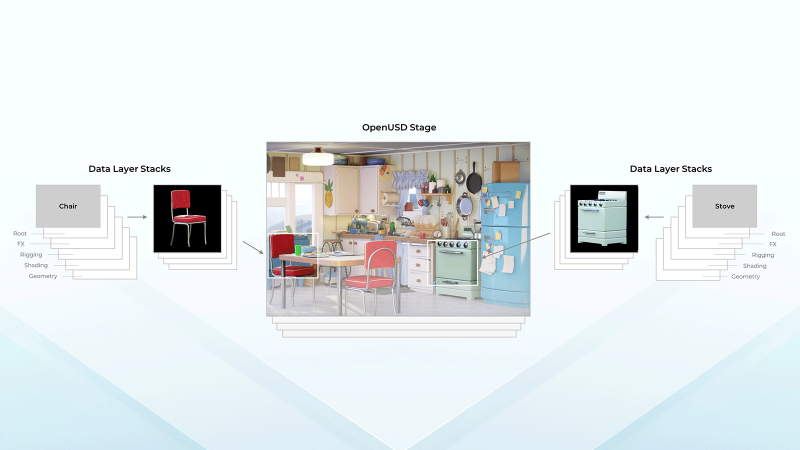Last week, the Alliance for OpenUSD made a series of announcements as they continue to mark quick progress in their mission to promote the interoperability of 3D content through openUSD. The group has moved impressively in promoting this Pixar creation through a number of different industries, with the Alliance having been founded only last year and already adding a number of companies into the fold from a variety of industries, while also releasing a two-year roadmap. Most recently, in addition to more members joining the group, they also announced the creation of two new working groups within the Alliance.
There were eight new general members announced in AOUSD’s latest announcement, one of which being Trimble. The company also announced this week that USD will be incoporated into SketchUp workflows, as the solution will now leverage the NVIDIA Omniverse platform. Recently, Geo Week News spoke with Sean Snyders, a research manager with the company who also wrote the linked blog post, to talk about the growing awareness around USD, where Trimble sees itself in this ecosystem, and why USD is so important for the AEC and geospatial industries, and the broader economic ecosystem.
Prior to joining Trimble, Snyders had worked in the film industry, giving him a different perspective on USD than others in the AEC and geospatial sectors since it was originally created for those contexts. Working on films such as The Hobbit and Avatar – two massive productions with plenty of digital assets mixed in with real-world footage – he saw first-hand why this kind of technology was needed in that context. In viewing things through the lens of our industries, the issues sound pretty similar.
“We essentially had the same problems that USD eventually solved. We had to wrangle vast amounts of data – for example, with Avatar I think we generated a petabyte of data – and we had different types of artists and different people that had varying processes. All of the same pipelining and collaboration problems that we have in the AEC space, we had in the film industry as well.”
Perhaps the most interesting piece of AOUSD from the outside is the sheer diversity in companies involved in the effort. The founding companies include some of the biggest in the world, such as NVIDIA and Apple, in addition to Pixar, while other members range from companies familiar in our industries like Hexagon and Cesium, to companies we know from other parts of our lives like IKEA, Lowe’s, and Meta. The opportunity to work with other industries was part of what piqued Trimble’s interest, according to Snyders.
“We see the benefits in wider adoption and collaboration technologies. So, standards as it is for interoperability, but also for collaboration amongst different industries.”

As for where Trimble itself sees itself in the context of this collaboration, Snyders tells Geo Week News that they view themselves as leaders for AEC in this context.
“As USD started from the film industry, there’s not yet leadership in terms of AEC space on the standards. So we thought, Okay, having the expertise in this space, we are essentially leaders there. We can draw that expertise and help that standard move forward in this domain.”
One of the aspects of USD that stands out, both in general conversations and our conversation with Snyders, is that people generally know that they need this kind of tool to streamline their work, but they aren’t exactly familiar with USD specifically. Snyders relays similar conversations with his customers who are looking for better interoperability.
“We see our customers are demanding more and more interoperability. They’re demanding more ways to actually interact with different tools, different ecosystems. The USD ecosystem is quite wide, so that is something that piqued our interest from the beginning.” He added that USD would give the ability to “provide Trimble’s great, high-precision data and ground truth data into other industries.”
Snyders was also able to provide some insight into the working groups aspect of AOUSD, which was part of the announcement mentioned at the top of this article. The two new working groups are only the second and third that they have added, an intentional choice by the group.
“They intentionally restricted [the scope of their working groups] to focus solely on the main priorities in the beginning of the alliance, rather than fragmenting out. As soon as you fragment things too fast, it becomes difficult to manage and coordinate.”
That said, Snyders expressed interest in each of the new working groups – as well as the original core standards working group – that focus on materials and geometry. The latter in particular is “bread and butter” for much of Trimble’s work and the CAD environment more broadly.
Overall, what’s clear in this conversation with someone who has seen the development of USD and came from the same industry from which this ecosystem originated – and Snyders points out that USD is not a format, but a software ecosystem and platform for describing 3D geometry – is that its utility is broad and cuts across industries. The geospatial industry in particular can benefit, especially when considering how quickly the space changes.
“You can think about the amount of data in geospatial, and it’s just getting more and more every day. The richness of the data that we’re trying to represent is just massive,” Snyders said. “I think USD has the ability to be able to keep pace with innovation in the types of data that we’d like to represent. Today, it’s reality scans, or lidar, or photogrammetry. Tomorrow will be different types of technologies that come out, and we need to tie all of this stuff together. That’s what’s important for USD is to be able to do that flexibly and in a way that doesn’t stifle innovation, but brings along your legacy data as well.”





